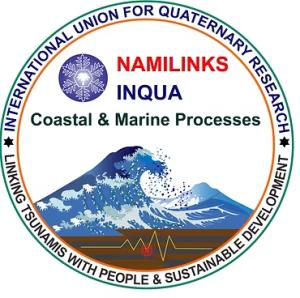INQUA 2101 se: Paleoseismic investigations to identify the source, magnitude and recurrence-interval of tsunamis on the global scale (NAMILINKS)
An ECR-led project to link Tsunamis with People and sustainable development.
Abstract
Tsunamis are the most devastating natural hazards on earth because of their high energy, short response time, unpredictable nature and the capability to cause mass destruction across the globe. The socio-economic and environmental collapse caused by the tsunami is sometimes irreversible! The 2011 Tohoku earthquake-associated tsunami and Fukushima reactor failure are examples of that. The 2004 Indian Ocean tsunami and its death toll of ~0.18 million people are an unforgettable memory. Recent research suggests many more such past events occurred across the globe.
However, the information on such tsunamis (source, magnitude and recurrence intervals, etc.) is incomplete in many areas of Mother Earth. High-resolution tsunami modelling based on this information has also not been done for many coastlines. Therefore, addressing this question has international importance. To eliminate shortcomings in our understanding of tsunamis, we need to change our perspective by employing advanced technologies on a global scale. For that, we need to find all data sets across the globe and classify them in a user-friendly manner for technological integration. This multi-year project is the first step towards that aim; therefore, we develop networking among early career researchers (ECR) and experts working on tsunamis, collaborate with experts, collect data, and promote scientific exchange.
Therefore, this project will combine geological, archaeological, and historical research with technological support to solve the tsunami problem. Hence, this project will enhance our knowledge of tsunamis and create awareness of their impacts among people.
Objectives:
- Organize workshops and seminars on paleotsunami research, featuring leading experts, to train and engage Early Career Researchers (ECRs).
- Build a strong network of ECRs and create a comprehensive database of tsunami and storm deposits based on shared research and findings.
- Identify gaps in existing tsunami records across global subduction zones and pinpoint promising sites for future research projects.
Project leaders
- Frango C. Johnson, IIT Kanpur, India
- Beverly Goodman Tchernov, University of Haifa, Israel
- Laurence Audin,Institut de Recherche pour le Développement – ISTerre, France
- Raphaël ParisLaboratoire Magmas & Volcans, France
- Isabel Hong, Simson Fraser University, Canada
- Anandasabari Karthikeyan, National Institute of Ocean Technology, Chennai, India
- Sambit Prasanajit Naik, Pukyoung National University, South Korea
- Asmita Mohanthy, NIAS, India
- Gurvinder Singh, IIT Kanpur, India





